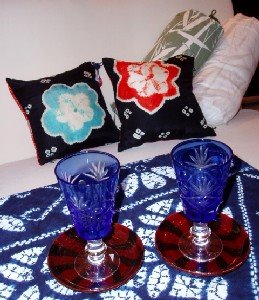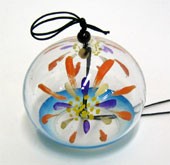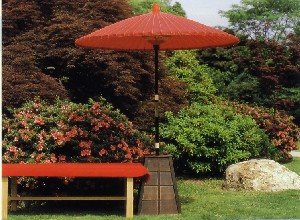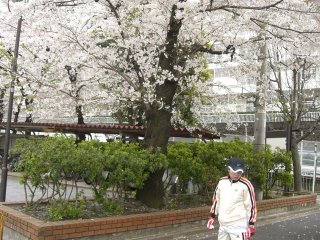Saturday, April 02, 2011
Saturday, January 23, 2010
Japanese trends - valentines day & white day
gifts are exchanged on/around February 14 and March 14.
内容: Google トレンド: valentines day, white day, gift, ecology (Google サイドウィキで表示)Wednesday, June 27, 2007
Saturday, March 31, 2007
Thursday, August 03, 2006
Japanese Indigo Color – Feel of the Cool Summer Breeze




Japanese style summertime decoration can be created by the collection of the Japanese indigo colors. Japanese indigo dyeing uses the ecological natural colorant made of the igusa plant. The deep and beautiful indigo colors are created by the repeat of dyeing and drying work process for 15 to 20 times manually. Japanese indigo tie-dyeing fabric is used in this display as a table cloth. Matching “Hopper Cana” obi pillows are made from the Japanese obi. The same tie-dyeing technique is used for this obi pillow to create the beautiful flower designs.
In the hot summer season, cold drinks served by the Japanese kiriko cut glass are the best refreshment. Indigo color is one of the most popular colors of the kiriko cut glass. Beautiful seasonal flowers are arranged in the Arita old hibachi (antique Japanese brazier) of indigo and white. Cool and nice summer interior décor is created by the collection of Japanese indigo color items. Japanese indigo color collection is the perfect items to decorate your room in a nice and refreshing Japanese style.
Collection of the Japanese indigo items from the Hospitality Japan.com Boutique
"Hopper Cana" Obi Pillow #19
Kiriko Cut Glass
Tengoqoo Indigo Sake Cup
From Cecilia

Hospitality Japan.com "Japan"ese Boutique
Hospitality Japan.com
Wednesday, July 19, 2006
Edo Furin - Japanese Glass Wind Bell


Name of Edo Furin derives from that Mr. Yoshiharu Shinohara, Jr. made a factual survey on a glass wind-bell and started the name of Edo Furin.
A certain Senryu – short humorous verse says:
Many people gather at street corners without any peddl-er’s cry,
That is because inherent charms of the wind-bells by the gentle wind attract the people.
In the late Edo period (1603-1867) soft and comfortable sounds of the glass wind bell were heard at every corner of the town of Edo. The peddlers were carrying the bells on a pole and it was unnecessary for them to offer the bells for sale by shouting their wares, because the ring of the bells in the breeze was the best way of shouting for sale. The foregoing short verse shows the town’s atmosphere of Edo.
 At present, it seems that hardly any craftsman is at work but Mr. Yoshiharu Shinohara, Jr., manufacturer of this Edo Furin, who can hand down the technique of manufacturing the traditional wind-bell to posterity. He has designated his eldest son as his successor and is making his efforts to keep the fire of a melting pot alive. In 2005, Mr. Yoshiharu Shinohara, Jr. was given the title of honorable citizen of Tokyo Metropolitan City for his contribution to develop the skill of the craftsman of Edo Furin.
At present, it seems that hardly any craftsman is at work but Mr. Yoshiharu Shinohara, Jr., manufacturer of this Edo Furin, who can hand down the technique of manufacturing the traditional wind-bell to posterity. He has designated his eldest son as his successor and is making his efforts to keep the fire of a melting pot alive. In 2005, Mr. Yoshiharu Shinohara, Jr. was given the title of honorable citizen of Tokyo Metropolitan City for his contribution to develop the skill of the craftsman of Edo Furin.
Now, Yoshiharu produces the bells together with his sons, Yutaka and Masayoshi.
An Edo Furin made of glass is more colorful and comfortable in sound as compared with a bell made of iron. Various kinds of the glass wind bells resonate and are in harmony and change in sound as wind blows. Even in the modern era, the sound of wind bells is still a summer feature and the clear sound makes us feel cool.
The real Edo Furin is hand-blown and painted from the inside which is only created by the special artisans of the wind-bells.
 Maruyoshi is established by Yoshiharu’s 2nd son, Masayoshi in 1990 preserving the prescious tradition of Edo Furin but providing a fresh breeze with new ideas to the family business of craftsmanship. Maruyoshi sincerely wishes that you could enjoy the delightful sounds of Edo Furin and the bell would be kept carefully in your home for many and many years to come.
Maruyoshi is established by Yoshiharu’s 2nd son, Masayoshi in 1990 preserving the prescious tradition of Edo Furin but providing a fresh breeze with new ideas to the family business of craftsmanship. Maruyoshi sincerely wishes that you could enjoy the delightful sounds of Edo Furin and the bell would be kept carefully in your home for many and many years to come.Signed by Masayoshi Shinohara.

From Cecilia
Hospitality Japan.com "Japan"ese Boutique
Hospitality Japan.com
Monday, July 03, 2006
Japanese style summertime sensation
 Japanese style life enjoys the change of four seasons. Seasonal traditions are often considered to value the best of the season and integration with the nature. Therefore there are many wise feature of summer to stay cool without being inside of the air-conditioned rooms.
Japanese style life enjoys the change of four seasons. Seasonal traditions are often considered to value the best of the season and integration with the nature. Therefore there are many wise feature of summer to stay cool without being inside of the air-conditioned rooms. 
Nodate parasols are originally used for the tea ceremony. They provide a good shade from the sunshine. Host prepares the tea in front of the guest sitting on the bench under the parasol. Guests enjoy viewing the seasonal flowers and freshly whipped green tea.
 Nodate set is a very handy Japanese tea ceremony set for outside serving. In a very pretty Japanese basket bag, tea cup, bamboo tea spoon (folding type), tea whisk, and natsume green tea container are contained. Size of the Japanese pottery tea cup is 9.5D cm x 6.5H cm (3.74 x 2.56 inches).
Nodate set is a very handy Japanese tea ceremony set for outside serving. In a very pretty Japanese basket bag, tea cup, bamboo tea spoon (folding type), tea whisk, and natsume green tea container are contained. Size of the Japanese pottery tea cup is 9.5D cm x 6.5H cm (3.74 x 2.56 inches). Japanese fans are handy as they are usually folded into a small piece when not in use. You can get the natural breeze by opening the fans. In addition, you look very elegant by using these beautiful fans.
Japanese fans are handy as they are usually folded into a small piece when not in use. You can get the natural breeze by opening the fans. In addition, you look very elegant by using these beautiful fans.Decoration fan looks great for both as an interior décor as well as a practical item. This pine tree design traditional Japanese fan is 28.8cm (11.39 inches) wide when it is open.
 This beautiful Arita Japanese pottery ware with floral branches design is a beverage serving container with tap. Ice container to chill the wine or other drinks without diluting with water is placed inside of the stand. Server contains 2,350cc liquid. Size: 30.2x9.5x17.7cm (11.89x3.74x6.97 inches).
This beautiful Arita Japanese pottery ware with floral branches design is a beverage serving container with tap. Ice container to chill the wine or other drinks without diluting with water is placed inside of the stand. Server contains 2,350cc liquid. Size: 30.2x9.5x17.7cm (11.89x3.74x6.97 inches). To check price in your currency, please click here. Variety of Japanese items is also available in the Hospitality Japan.com Boutique.
 From Cecilia
From CeciliaHospitality Japan.com "Japan"ese Boutique
Hospitality Japan.com




